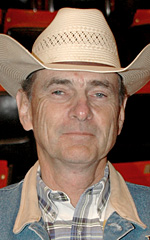 Ranchers know cattle, but farmers deal the dirt. That was the reason the National Cutting Horse Association called on Bob Kiser (pictured) last year.
Ranchers know cattle, but farmers deal the dirt. That was the reason the National Cutting Horse Association called on Bob Kiser (pictured) last year.
The NCHA holds its three events at Will Rogers Equestrian Center. The Ford NCHA Super Stakes, which concluded on April 15, was the latest NCHA show to benefit from Kiser’s expertise.
An Illinois corn and soybean farmer turned entrepreneur, Kiser designed an innovative new harrow or “drag” to maintain arena floors. The National Reining Horse Association has used Kiser’s system since 1988; the American Quarter Horse Association consulted Kiser in 1999 and has been using Kiser’s DragMaster at their three major shows for the past eight years.
“It’s been fantastic,” said Dave Brian, NCHA’s director of shows, of Kiser’s drag. “The beauty part is that the arena floor is level from start to finish, so everybody has the same chance. Every time a new set starts, the arena floor is the same as it was before.”
The Super Stakes was a 20-day event that involves 1,800 entries vying for a total purse of $3.14 million. There were seven to nine sets of 12 to 15 riders most days, and at the conclusion of each set, the ground was worked with a drag in preparation for the next. The show used a total of 9,000 cows — milling, dodging and running — not to mention the impact of the horses themselves, and at the end of each set, the arena floor resembled a dry riverbed minus the rocks. The NCHA has struggled to keep the ground consistent with an eight-inch base consisting of dirt and sand, topped with three inches of pure sand – a total of 1,400 tons.
After a day spent watching competition at the NCHA Super Stakes at Will Rogers Equestrian Center in Fort Worth last year, Kiser knew what needed to be done to meet NCHA’s challenges with the arena surface.
“Most of it was because the drag they were using didn’t work the whole soil profile,” he explained. “The ground changed from a hard to a shallow surface and then, as the horse got to the outside [of the working area], the sand got deeper. Everywhere the horse went, he was on a different type surface. And when horses went to stop in the deep sand on the sides, it took a lot of effort to get up out of there and that’s how injuries occur.”
The NCHA implemented Kiser’s plan with a DragMaster fitted with a water tank for the first time during the NCHA Futurity. The improvement was dramatic.
Kiser got involved in the business of arena maintenance when he owned reining horses and the National Reining Horse Association came to him for advice.
“They were having a lot of trouble with their ground and asked me if I knew anything about it,” he explained. “I really didn’t except that I knew a lot more about working sand and dirt than most people. And it’s turned into quite a business for us.”
Kiser built an international business with Absolute Innovations Manufacturers and Drag Master. In addition, his reputation as an arena specialist keeps him on the move, with clients as far-flung as Argentina, Poland, Germany, Spain, the Netherlands and Belgium.
“Experts in the field of horse injuries tell us that 80 percent of injuries are related to improper footing,” Kiser noted. “With all the rules and regulations that these associations have in place, there are no specifications for the ground, and that is one of the most important factors.
“My goal is to make it so that people have the same good footing wherever they show at major events,” he said.
